Presidents Cup
The Royal Montreal GC

PLAYERS RANKINGS

PLAYER RANKINGS

TaylorMade Tour Response, Soft Response golf balls: What you need to know
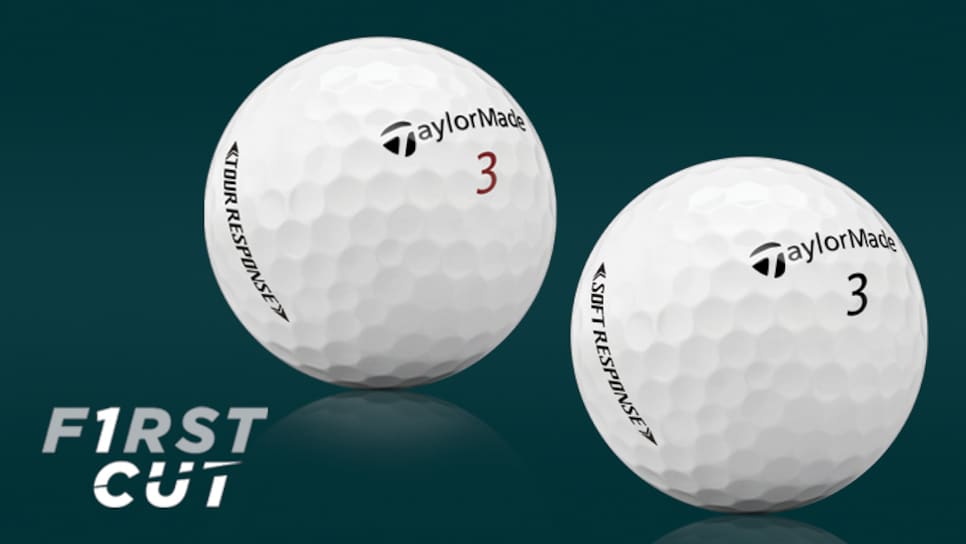
WHAT YOU NEED TO KNOW: TaylorMade again targets average golfers with its latest updates to the Tour Response and Soft Response balls. The three-piece Tour Response incorporates the new dimple pattern and cast urethane cover of its tour-played TP5 balls for better flight and higher spin, but it features a softer compression aimed at non-tour-level swings. The low-compression Soft Response, which is a three-piece ball with an ionomer cover, enhances distance and softer feel with its firm mantle beneath a softer but durable cover.
PRICE: Tour Response and Tour Response Stripe, which features a wide aiming line along the circumference of the ball, $40 per dozen. Soft Response, $30 per dozen.
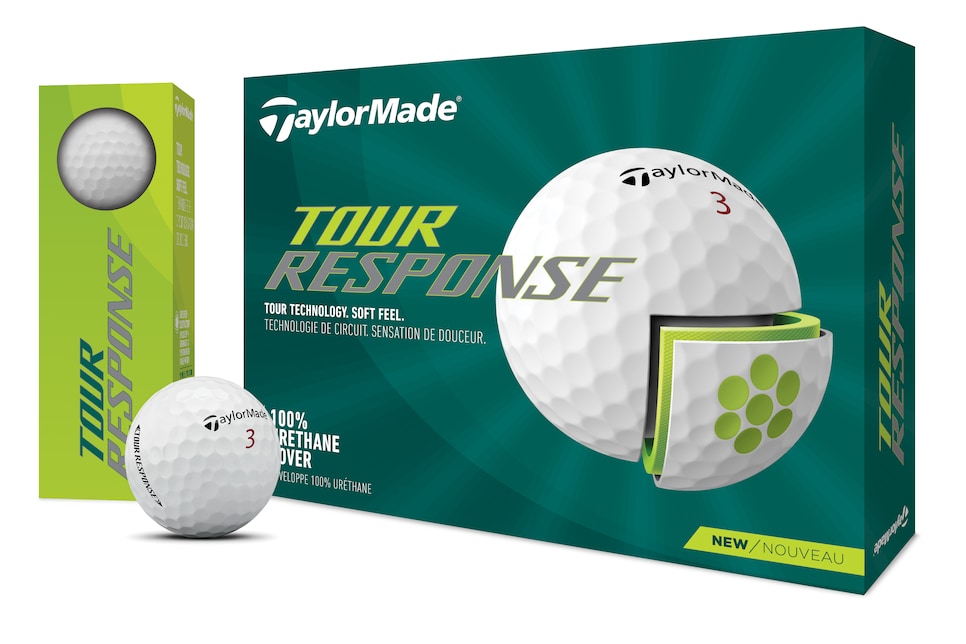
THE DEEP DIVE: Among the endless cycle of deficiencies average golfers face when comparing themselves to tour players is, of course, speed. Speed, or more specifically the lack of it, is a particular problem when it comes to the golf ball because while speed keys distance, it is fundamentally difficult to maximize speed in a golf ball that’s designed for players whose lack of speed leads them to gravitate toward a golf ball with a lower compression.
TaylorMade’s new Tour Response and Soft Response balls, updated for 2022, are going after that need to enhance speed for average golfers by focusing on the smallest and even sometimes unseen elements of the construction of the ball. In simple terms, the Tour Response offers tour-ball-like spin and control through its cast urethane cover with distance-enhancing elements in its dimple pattern, mantle layer and core, while the Soft Response uses the unseen mantle layer in its three-piece construction to energize the company’s softest ball with more resilience for better distance.
The second-generation Tour Response features a 70 compression, among the softest of balls with a multilayer urethane construction. That normally makes it harder for the ball to maximize speed because it lacks the resiliency at impact of a firmer compression ball like those seen in the company’s TP5 and TP5x balls. But the Tour Response borrows the speed-enhancing effects of those ball’s mantle layer to inject more energy into its softer compression.
Called “SpeedMantle,” this element works with the core more efficiently due to a higher flex modulus than previous mantle layers designed for both its predecessor and similar average player “tour” balls like the company’s Project (a) , said Ben Raymond, senior golf ball engineer at TaylorMade. “Aside from being a higher flex modulus, this is also a more resilient material so it retains energy better after impact for higher ball speeds,” he said.
What makes the Tour Response even more effective at giving average golfers the distance their lack of speed can’t naturally provide them is its cover. Specifically, it uses the same sort of dimple design found on the TP5 and TP5x balls . Rather than the typical spherical shaped depressions in the cover, the Tour Response uses a dimple that’s flatter, shallower but with steeper sides. That creates the same volume for better air flow but yields better performance at a broader range of speeds, Raymond said. The key was looking at how the ball moves through the air at everything from 60 miles per hour to north of 160 miles per hour.
“Aero is really all about optimizing lift and drag, and the volume and the depth of your dimple shape are really the main influencers of lift and drag,” he said. “With our spherical dimple before, when you’re changing volume, you’re changing depth and you’re also impacting lift and drag in the same way. So being able to decouple the volume and the depth allowed us to decouple lift and drag and really optimize for each stage of the ball flight.
“When we test this we look at 24 different conditions of speed and spin. When you’re looking at aero you still have to account not just for the initial velocity but the entire range of velocities throughout flight. That’s what we mean when we talk about optimizing lift and drag. It’s not just for one speed, it’s for the entire range of speeds that ball may experience.”
Raymond said while previous patterns were very good with the high speeds right off the face of a tour player’s driver, it’s later, when the ball is moving at the same speed for all players, that the new dimple is most beneficial. “The 'a-ha' moment came when we learned that when the ball peaks in flight and starts to descend there’s an opportunity to manipulate drag and lift in that part of the flight, too,” he said. “We could elevate lift to keep that ball in the air longer.”

That dimple pattern might be noticeable to the average player’s eye, but even more distinct is a version of the Tour Response called Tour Reponse Stripe. It features a wider alignment band in optic yellow that wraps around the entire ball. At 22 millimeters wide it’s more than half the ball’s total surface area.
“This is exciting for us because it gave us a whole new opportunity of creativity around a golf ball,” said Joshua Dipert, director of golf ball research and development. “The fact is you can pick up your ball and align it two or three times every hole, so why wouldn’t we give you some type of feedback or design some way to make that easier or beneficial?
“What we found was this design element not only was more accurate to align, it was quicker too.”
Another kind of quicker was behind the thinking of the Soft Response, which uses an ionomer cover like those found on many low-compression distance balls. The Soft Response features a three-piece construction that allows the ball’s overall softer compression to get distance from a firmer mantle layer between the cover and core, this despite the Soft Response’s 50 compression rating, which is ten points lower than its previous version.
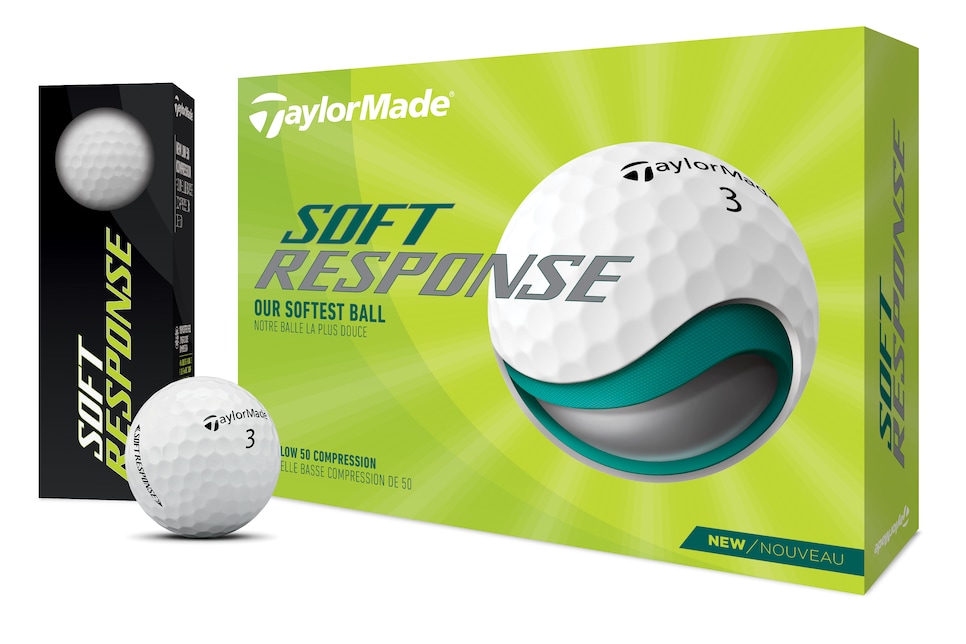
“With the softer two-piece ball you can get your speed through a firmer cover, but we’re able to use a faster, more resilient mantle layer to bump the speed up and still use a softer cover to maintain that feel, and get some better spin around the green as well,” Raymond said. He added that the company’s improved manufacturing processes and equipment allowed them to mix the firmer mantle with the softer elements “to maintain speed at a softer feel.”
The Tour Response (white and yellow) and Tour Response Stripe will retail for $40 per dozen. The Soft Response (white and yellow) will run $30 per dozen.
More from Golf Digest
Trending now.
TaylorMade Tour Response vs Soft Response Golf Balls [Comparison]

The Tour Response and Soft Response are new 2022 golf balls from TaylorMade that have a number of awesome new features. In this guide, we go over the TaylorMade Tour Response vs Soft Response golf balls and go through the features, pricing, and availability of each.
We’ll be going over:
- Key features in each golf ball
- What type of golfer each ball is made for
- How to buy the TaylorMade Tour Response and Soft Response golf balls today
- What I like and don’t like about each ball
After you read this, go and buy a pack of these new TaylorMade golf balls today and check them out for yourself.
- How to Buy the TaylorMade Tour Response and Soft Response
Tour Response
Soft response, what is the taylormade tour response, tour response stripe, key features, tour flight dimple pattern, urethane cover, three-piece construction, speedmantle, what is the taylormade soft response, extended flight dimple pattern, zno flex core, taylormade tour response vs soft response, dimple pattern, outer cover, number of layers, who is the tour response made for, who is the soft response made for, taylormade tour response/soft response vs tp5/tp5x, what i like about these golf balls, what i don’t like about these golf balls, frequently asked questions.

The TaylorMade Tour is the newest golf ball released by TaylorMade in 2022, providing great tour quality at an affordable price. These golf balls aren’t made to be a bargain, however compared to other premium golf ball brands on the market you definitely can’t go wrong with these.
For the first time ever, TaylorMade has added their patented Tour Flight Dimple pattern to the Tour Response ball, which has previously only been found in the TP5 and TP5x balls. The 100% Urethane cover provides the softest feel in a golf ball which will help maintain distance while also keeping spin and distance control.
The new TaylorMade Tour Response golf balls were released on March 18 th , 2022 and come in white, pure yellow and also a one-stripe colorway. These golf balls are similar to and often compared to the Bridgestone E6 and E12 golf balls .
The Tour Response Stripe is a custom ball released by TaylorMade on the same day as the regular Tour Response. It carries the exact same features and feel as the Tour Response, but will be more loved by alignment lovers.
The Tour Response Stripe features a 360 degree, 22 millimeter alignment stripe running around the centre of the golf ball to help with aiming. The stripe is yellow with a thin black line on the inside that matches up with the player’s putter sight lines.
This will help ensure that amateur golfers have their putts lined up correctly. The stripe also helps provide a type of feedback to the golfer on the roll of each putt.

TaylorMade introduced their patented Tour Flight Dimple pattern on the TP5 and TP5x golf balls and it has now made its way over to the Tour Response ball. This dimple pattern has shallower dimples of equal volume, meaning the ball will carry farther in the air for maximum distance.
The 2020 version of the Tour Response had deeper dimples, which hindered the ball flight slightly. Golfers with average swing speeds should find immediate improvement from the new Tour Response dimple volume vs the 2020 version.

The new Tour Response balls have a 100% Urethane cover on them, which provides a softer ball feel. These balls have maximum durability. Urethane is a stronger bonded material than Ionomer, which will ultimately provide a softer feel.
The softer feel also increases interaction with the grooves on your clubs , which will help generate more spin and control.

The new Tour Response balls are a 3-piece construction that is designed to maximize efficient energy transfer in your swing and produce incredibly fast swing speeds. This, along with the soft feel of the Urethane cover will help the ball explode off the face at impact.
Another feature taken from the TP5 and TP5X, SpeedMantle is a feature that allows the mantle (inner core of the ball) to flex better on impact. This feature helps to increase distance in the ball.

The new TaylorMade Soft Response is the softer golf ball of the new releases. Soft golf balls are more geared towards moderate to slow swing speeds as they provide a little more feel at impact. The Soft Response utilize a soft Ionomer Cover on the ball, which helps increase the feel and also provides great durability hit after hit.
Overall, it has a softer core than most other balls on the market. The lower spin rates are more forgiving though, making it easy to keep the ball on track. Greenside spin is also minimized and the landing on the ball will be soft.
The Soft Response released on March 18 th along with the new Tour Response balls. The Soft Response balls are designed more for the golfer that is looking for soft feel without sacrificing any sort of distance on their shots.
The Soft Response balls have a shallower U-shaped dimple pattern on them. This new dimple profile will promote less drag off the tee and also an increased ball flight at impact. This should allow the ball to stay in the air longer with low spin rates.

The new TaylorMade Soft Response golf ball is more geared towards slow swing speed golfers. They have an ultra-low 35 compression core , which provides a soft feel in the golf ball all while keeping maximum impact off the tee. These balls carry far even on slow swing speeds!

The TaylorMade Tour Response vs Soft Response, each ball has a number of unique features. Other than release date, the two balls have a different design and purpose. Let’s break down these components in more detail.
Although each golf ball released has a different dimple pattern, the premise is still the same. The Soft Response has the shallower U-shaped dimple pattern, whereas the Tour Response has the new Tour Flight pattern.
Each still promotes less drag off the tee and promotes higher ball flight which in turn equals farther distance with less spin.
The Soft Response have a soft Ionomer cover on the ball whereas the Tour Response is a 100% Urethane cover.
The Ionomer cover will definitely give a softer feel, but that is what the Soft Response is marketing towards. The Tour Response balls still have a very soft feel for a Tour-ball and you will not sacrifice any distance with them.
The new TaylorMade Tour Response balls start at $43.99 USD for a case, whereas the Soft Response balls only start at $27.49 for a case. This is quite a big price gap between the two and there are a couple of reasons for this.
The Tour Response balls are geared towards high swing speed golfers, which will be the low handicap and tour players. You will find PGA Tour players using these balls all the time.
The Soft Response balls are geared towards slow swing speed players, which are the amateurs and regular weekend golfers. You will never find a PGA Tour player using the Soft Response ball because they are looking for maximum distance and maximum durability, which the Soft Response can’t provide.
Either way, the pricing on both of these are excellent compared to some of the other golf ball brands out there.
Both the Tour Response and Soft Response golf balls are a 3-layer constructed golf ball. Both incorporate new dimple patterns to help promote ball flight and maximum distance with swing speeds ranging from slow to fast.
The Tour Response feature a Urethane cover which will promote more spin, where the Soft Response has an Ionomer cover which will have a softer feel and less spin.

The new Tour Response golf balls are made for low to mid handicap golfers looking to enhance ball speed and spin. It is for moderate swing speed players looking for tour-like spin while also increasing distance.
The Tour Response has the Tour Flight dimple pattern taken from the TP5 and TP5x balls. The new dimple patter gives the balls speed-enhancing effects. The 100% Urethane cover is soft and the everyday golfer will find success using the ball.
The new Soft Response golf balls are made for those amateur golfers with a slower swing speed that are looking for a soft feel while not sacrificing as much distance. They feature a soft Ionomer cover on the ball that provides durability.
With the shallower U-shaped dimples, it still allows the ball to carry through the air so you won’t lose as much distance. These balls are perfect for the high handicap golfers and regular weekend golfers.
If you are still trying to establish your handicap , the Soft Response is for you.
The TP5 and TP5x have been revelations in the professional golf ball world since they were introduced back in 2017. Many PGA Tour players have won using them and they are still used today. TaylorMade has just recently released the new Tour Response and Soft Response golf balls so we will compare them to the TP5 and TP5x.
The Tour Response and Soft Response are definitely great affordable alternatives for mid to high handicap golfers. They cost quite a bit less than the TP5 options.
The TP5 and TP5x are a five-piece construction and are a very firm golf ball compared to the Tour Response and Soft Response. They seem to launch off impact and keep their line quite a bit more compared to the softer models. They also keep a lower spinning ball flight, especially through the wind which will result in further drives.
The TP5 and TP5x are also quite a bit more expensive since they are a tour golf ball. A dozen TP5x balls can cost over $60, which is nearly double what the Tour Response does.
Lower handicap players will definitely prefer the TP5 and TP5x as they will provide further distance, more spin and overall enhanced tour feel.
The Tour Response golf ball is a really good mid-quality golf ball for average golfers. Adopting the same dimple pattern as the TP5 golf ball is smart design by TaylorMade. However, the half price point is better for casual golfers to spend.
The Soft Response golf balls are one of the easiest golf balls I’ve ever hit on the golf course. They are perfect for beginner golf balls who want a reliable golf ball from a top brand. Once you can hit faster ball speeds, then an upgrade to the Tour Response will be beneficial.

Being softer golf balls, these aren’t great for practicing your backspin. This is fine for most casual golfers, but something to consider if you want a more advanced feel.
The Tour Response Stripe version also feels a little pointless to me. They are designed for more experienced golfers anyway who don’t need to rely on a big obnoxious line around the ball. I would have liked to see the stripe on the Soft Response for newbies to try out.
In conclusion, the Tour Response and Soft Response balls are a great option if you are looking for a cheaper alternative to premium tour golf balls. They provide a high launch, while holding consistent distance and the soft feel is great especially around the green.
Tour Response vs Soft Response, both golf balls from TaylorMade have a ton of really nice features. The Soft Response is a great golf ball for recreational golfers who want to simplify their game. It might be the softest ball on the market.
For a better feel and more control, the Tour Response offers next-level aerodynamics. It is a softer version of a tour level ball.
Both of these TaylorMade golf balls are worth trying out today. The price point for them is very reasonable.
Use the links below to buy these golf balls today.
What professional golfers use the Tour Response and Soft Response golf balls?
A lot of PGA tour professionals use the TaylorMade TP5X golf ball, including Dustin Johnson and Rory McIlroy. The Tour Response golf ball should be picked up by some of the pros soon, but the ball has just only hit the market. We’ll be updating this guide as soon as we see some professionals using the ball.
What is the compression of the TaylorMade Tour Response?
The Tour Response has a low 70-compression design. This means that it should be used by golfers who have a swing speed around 70 MPH. A low compression golf ball has better rebound off the club when hit, but are a little tougher to control.
What is the compression of the TaylorMade Soft Response?
The Soft Response has a really low 50-compression design. This means that it should be used by golfers who have a swing speed around 50 MPH. A really low compression ball like this maximizes energy transfer when it is hit, letting it travel a longer distance with a slower speed.
Does the TaylorMade Tour Response replace the Project A golf ball?
The Tour Response does in fact replace TaylorMade’s Project A ball. It provides a cheaper and more affordable golf ball, while retaining some of the key features found in the more expensive TP5 and TP5X.
Ryan William
With over 25 years hands-on experience in the golfing world, Ryan is not just an avid golfer but a topical authority. His journey has had him delve deep into the nuances of the sport, from mastering the swing to understanding new golf technology. As an entrepreneur, Ryan is at the forefront of the latest golf trends, reviewing all new clubs, accessories, and training aids. His insights and expertise are backed by a prolific writing career, with over 1000 articles published across various platforms. Ryan's commitment is clear: to guide and inform the golf community with unparalleled knowledge and passion.
Last update on 2024-09-27 / Affiliate links / Images from Amazon Product Advertising API
Leave a Comment Cancel reply
Save my name, email, and website in this browser for the next time I comment.
Modern Golf Apparel
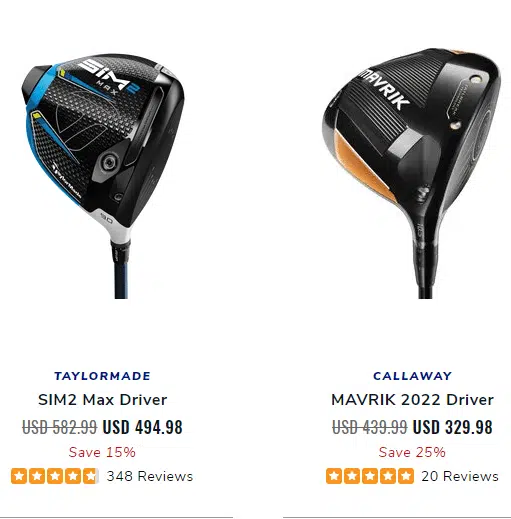
Save on TaylorMade, Callaway & more!
TaylorMade Tour Response vs Titleist Pro V1 golf balls
Published: 10 August 2020 Last updated: 06 October 2021

TaylorMade Tour Response vs. Titleist Pro V1 golf ball
The TaylorMade Tour Response golf ball promises premium tour-level performance at a compression and price to suit an amateur golfer’s swing speed and budget… but how does it perform against the market-leading Titleist Pro V1?
After surveying thousands of average golfers and listening to what they wanted from a golf ball, TaylorMade came up with the three-piece Tour Response. They were targeting amateurs who were playing golf balls that weren’t suited to them, hoping to provide a product that not only performed better, but at a cheaper price point.
Related: Best Premium Golf Balls
The intention was to lure people away from premium tour balls like the market-leading Titleist Pro V1, so we thought it made sense to compare the two head-to-head to see how they stack up and which one is better for your golf game.
Construction and cover: TaylorMade Tour Response vs Titleist Pro V1
Both the TaylorMade Tour Response and Titleist Pro V1 are three-piece golf balls with a 100% urethane cover. It’s urethane that makes a ball feel soft and helps with grab and control when it hits the green.
Urethane has typically only been used on premium tour balls, with cheaper balls having surlyn and ionomer covers which don’t sound and feel as soft, or provide as much short game control and spin. Thankfully, that is changing, with Tour Response is a ball aimed squarely at amateurs but still offering the urethane cover that discerning golfers will want.
Balls like the Callaway ERC Soft and Titleist Tour Soft feature blended covers, which can’t match what you get from 100% urethane.
RELATED: Revealed – The right golf ball for your game

Compression: TaylorMade Tour Response vs Titleist Pro V1
The Titleist Pro V1 has a compression of over 100 (our robot golf ball test measured it at 101.8), while the Titleist Pro V1x has a compression of 108.4, making it the firmest golf ball in our entire test. That’s because they’re designed for tour players with swing speeds typically in the range of 110-130mph.
Related: Which TaylorMade iron is right for you?
The TaylorMade Tour Response has a compression of 70, which makes it far easier to compress for golfers with more average swing speeds, helping amateur golfers get more ball speed and distance.
TaylorMade Tour Response vs. Titleist Pro V1 – Price
The Titleist Pro V1 has an RRP of £52 per dozen, which works out at £4.33 per ball.
The TaylorMade Tour Response has an RRP of £39.99 per dozen, which works out at £3.33 per ball, 23% cheaper than the Titleist Pro V1.
Related: Today’s Golfer Editor’s Choice Awards winners revealed!

TaylorMade Tour Response vs. Titleist Pro V1 – Feel
Thanks to the urethane covers, both balls feel pleasantly soft and sticky in the hand, in contrast to surlyn balls which feel hard and less grippy.
Related: Titleist Pro V1 2021 golf ball review
TaylorMade Tour Response vs. Titleist Pro V1 – Performance
In our test, the titleist pro v1 was one yard longer off the tee (a difference of 0.4%) than the taylormade tour response..
With a 7-iron, the TaylorMade Tour Response was 13 yards (8.8%) longer than the Titleist Pro V1, which means you more than gain back any loss from the driver.
Related: Seed Golf vs Titleist Pro V1 golf balls
There’s always the worry that golf balls carrying further with irons will mean lower spin and shots that don’t stop on the green. In fact the TaylorMade Tour Response launched higher, had a higher peak height and the same descent angle as the Titleist Pro V1, meaning shots will hold the green. The extra distance came from a ball speed that was 3mph faster than the Pro V1.
The Titleist Pro V1 generated 11% more wedge backspin, but again the Tour Response launched higher, peaked at the same height and fell onto the green at a slightly steeper angle, which meant shots still checked up.
Related: Callaway Chrome Soft vs Titleist Pro V1 golf balls
Data comparison: TaylorMade Tour Response vs Titleist Pro V1

Key numbers: TaylorMade Tour Response vs Titleist Pro V1

Related: Titleist TSi driver review
Verdict: TaylorMade Tour Response vs Titleist Pro V1
Overall, for club golfers, the TaylorMade Tour Response golf ball is an excellent alternative to the Titleist Pro V1. Unless you boast a tour pro swing speed, it will likely offer improved performance at a cheaper price point.
READ MORE TITLEIST NEWS, REVIEWS AND TESTS
TESTED: Srixon Q-Star Tour vs Titleist Pro V1 golf balls
REVIEW: Titleist Pro V1x 2021 golf ball
TESTED: Titleist TSi drivers

Review by: Simon Daddow
Job title: Today’s Golfer – Equipment Editor


Taylormade Tour Response vs Callaway Chrome Soft
As an affiliate, we get paid from qualifying purchases made using the links in this post.
The new Taylormade Tour Response vs Callaway Chrome Soft golf ball comparison is long overdue. Most golfers are looking to buy one of these two golf balls, but don’t know which to get. Some are unable to decide because they feel like there isn’t enough information.
This Taylormade Tour Response vs Callaway Chrome Soft ball review is here to help.
Last update on 2024-09-24 / Affiliate links / Images from Amazon Product Advertising API
Taylormade Tour Response
The first ball we will compare is the Taylormade Tour Response.
The design of the Taylormade tour is a three-layer ball with a softcore. The outer layer is designed to minimize the spin, while the inner core speeds up the ball .
The Taylormade Tour Response offers a low-compression golf ball with a high launch and low drag. When compared with other similar products, this ball carries farther, but it also has a lower compression which may make some golfers feel like they are too low of a launch.
The Taylormade Tour Response offers a soft feel, but it does have an unusually hard core which may impact some golfers negatively.
Please enable JavaScript

Performance:
This is the perfect ball for beginners and players with higher handicaps due to its low compression rate of 75. Taylormade Tour Response has a very fast speed rating, allowing you to swing faster without losing distance. It also comes in two different hardness ratings, soft and extra soft. The ball also has a lower spin rate which is best suited for players who struggle to stop their shots quickly.
Callaway Chrome Soft
The next ball we will compare is the Callaway Chrome Soft , one of the most popular golf balls on the market today.
The Callaway Chrome Soft is a three-layer ball that has an outer cover for a lower spin, and low compression inner core which allows for increased speed at impact. The more effectively the company can manage the speed of their golf ball , the longer it will travel through the air. This is why companies often make different balls with different cores for different kinds of golfers . This is why the Callaway Chrome Soft ball has an 80 compression rating, which is between soft and medium.
The distance rating for this ball ranges from 236-285 yards (depending on your club), with a medium spin rating, but it can travel 350 yards if you use a driver or pitching wedge. This is why this ball is great for mid to high handicap players, but it may not be the best choice for beginners.
The Callaway Chrome Soft offers slightly more spin than the Taylormade tour, which makes it better at stopping once in flight. The cover of the ball is also softer, which means it feels more comfortable on the green.
This golf ball has a lower compression rate than Taylormade Tour Response, but not by much. The two different hardness ratings allow players to select the option that they prefer best. The low spin rate of the Callaway Chrome Soft makes it great for high-speed swings and also when you are looking to flick the ball. Both of these balls have a decent speed rating which means that they are both fast enough for golfers with higher swing speeds. With great performance and reasonable price, the Callaway Chrome Soft offers long-lasting value for money.
Perks of the Taylormade Tour Response
- The ball is designed with lower compression, meaning the highest speed swingers will likely prefer it.
- The low spin rate of this ball means that it is ideal for beginners who struggle to hit their target.
Perks of the Callaway Chrome Soft
- Offers slightly more control than the TaylorMade Tour Response ball.
- The soft outer layer of the ball makes it more comfortable on the green and gives you enhanced control over spin.
- The slightly higher compression means that faster swingers may prefer this option as well.
Perks of both balls
- They are both cheap, which means that players can try out a range of different balls without having to break the bank.
- Both balls come with a decent speed rating, making them ideal for most players, regardless of their swing speed .
- These balls are both durable and offer long-lasting performance.
Which one should you choose?
The Callaway Chrome Soft is easier to hit around the green and has better short game control, but it doesn’t go as far off the tee or the irons. The Taylormade Tour Response is longer off the tee and goes farther in general, but isn’t as soft or easy to control on short shots. If you need a ball that will offer good performance off the tee and around the green with long-distance, choose the Callaway Chrome Soft golf ball . If you just want something that’s long and durable, go with the Taylormade Tour Response.
Who would like the Taylormade Tour Response golf ball?
Players with higher handicaps and slower swing speeds will benefit most from the low compression rating of this ball. This makes it perfect for lower-speed swings and also for beginner-level players. If you tend to overshoot your shot, or if you struggle with stopping it on the green, this ball will reduce both of these issues.
Who would like the Callaway Chrome Soft golf ball?
Players who prefer a softer feel and also those who have a higher swing speed will benefit most from this ball . If you want speed and stopping power in your golf ball , this is one of your top options. The soft outer layer of the ball will also provide an additional level of comfort on the green and give you extra spin control.
Who wouldn’t like these balls?
Players who prefer harder balls or beginner-level players may not find this to be their preferred choice.
Frequently Asked Questions
Are callaway or taylormade balls better.
Both balls are great options, but they appeal to different golfers. The Taylormade Tour Response is ideal for beginners and players with handicaps of 13 or higher whereas the Callaway Chrome Soft excels when it comes to short game controls.
Is TaylorMade Tour’s response the same as Project A?
No. TaylorMade Tour Response is a soft-feel low compression golf ball designed for players with slower swing speeds while Project A is a three-piece performance golf ball marketed to better players.
Is Callaway chrome soft a good ball for seniors?
It depends. While many senior golfers do benefit from using soft compression balls because they are easier to compress for slower swings, the Chrome Soft is designed to fly further off the tee due to its aerodynamic design. This can be dangerous if you don’t have control over your shots and may end up landing in places that you didn’t intend to.
Do Taylormade golf balls have a warranty?
Taylormade warrants their golf balls for one year from the date of purchase. So if you bought a ball in January and it breaks in February, that is still within the warranty period. This only applies to the original purchaser who bought it from an authorized dealer, not if you got it as a gift or if you bought it from an unauthorized dealer.
What are the different types of golf balls available?
There are three types of golf balls based on their construction: two-piece, three-piece, and multi-layer. Two-piece balls have an inner core composed of one or more materials that are encased by a solid rubber or liquid metal mantle layer. Three-piece balls have an inner core composed of one material, surrounded by two layers called the mantle and the cover. The multi-layer ball has multiple layers including an outer jacket, a middle core, and an inner cover.
What is a three-piece golf ball?
A three-piece golf ball has an inner core composed of one material, surrounded by two layers called the mantle and the cover. The multi-layer ball has multiple layers including an outer jacket, a middle core, and an inner cover.

Why do you need a 3-piece ball?
Three-piece balls are designed to be more durable than two-piece balls because the mantle that surrounds it is made of solid rubber or liquid metal, which means that there are no seams to break. Three-piece balls also have higher compression and a soft feel so they provide better short game control.
What are the benefits of a three-piece ball?
Three-piece balls are more durable than two-piece balls but fly further because of their aerodynamic design. They also have high spin rates that make them ideal for players with slower swing speeds who need to control their shots.
What is an advantage of using 3-piece golf balls?
What is the best three-piece golf ball.
The best three-piece golf ball is the Callaway Supersoft Ball which has excellent short game control thanks to its soft compression, but it is slightly less durable than the Taylormade Supersoft Ball. The SuperSoft also has excellent short game control with its soft compression but is slightly less durable than the Taylormade Supersoft.
What is a 4-piece golf ball?
A four-piece golf ball has a high-energy inner core surrounded by an outer layer of low compression, softcover material which makes it easy to compress.
Why use a 4-piece ball?
Four-piece balls have a high-energy inner core surrounded by an outer layer of low compression, so they are very soft and easy to compress. This allows players of all abilities to have a soft feel which makes it easy to control and hit greens.
What is the difference between a 4-piece ball and a 3-piece ball?
Four-piece balls have a higher spin rate than three-piece balls because they have two layers around the core, making them ideal for players with slower swing speeds who need to control their shots.
What is the benefit of using a 4-piece ball?
Four-piece balls have a high spin rate which makes them ideal for players with slower swing speeds who need to control their shots. It also means that they are very soft and easy to compress, enabling all players of varying abilities to have a soft feel when trying to hit the ball .
What is the best 4-piece golf ball?
The best four-piece golf ball is the Callaway Chrome Soft X which has a soft feel, excellent short game control, and long-distance thanks to its low compression core wrapped in a layer of softer cover material for lower spin rates. It also has high durability because of its 330D Cordura material.
Taylormade Tour Response vs Callaway Chrome Soft – Conclusion:
If you are a beginner or someone who has a high handicap, the Taylormade Tour Response will give you better durability, control and better price. Meanwhile, the Callaway Chrome Soft will suit you if you are someone who struggles with short game control due to its lower compression rate, aerodynamic design for longer distance travel and soft feel which is easier to compress.
- Best Golf Apps For Your Galaxy Watch – Top Ten Picks (2022 Update) May 13, 2022
- Best golf shoes for Morton’s Neuroma May 5, 2022
- Best Ladies Electric Golf Trolleys April 21, 2022
- Best Budget Golf Watches to Help You Tee Off in Style April 14, 2022
- Best Golf Shoes for Plantar Fasciitis – Our Top 10 March 25, 2022
Related Posts
Why does bridgestone make golf balls.
Bridgestone Golf balls are world-renowned for their performance and durability. Tire company Bridgestone started making golf balls in 1935 with the intention of providing superior performance alternatives to traditional rubber balls. Today, Bridgestone Golf Balls offer consistent and accurate flight, even in windy conditions. With a long history of innovation, Bridgestone Golf Balls continue to…
Can You Remove Logo From A Golf Ball?
There are many ways to personalize a golf ball, but one of the most popular is to add a logo. But what if you want to remove the logo? But, can you remove a logo from a golf ball? In this article, we’ll explore some methods for removing logos from golf balls. Can you remove…
How Much Does It Cost To Make A Golf Ball?
How much does it cost to make a golf ball? Surprisingly, the answer is not as straightforward as you might think. There are many factors that go into the production of a golf ball, including materials, labor, and shipping costs. In this article, we will take a closer look at how golf balls are made…
TaylorMade Tour Response Review – Worth The Price?

Matt Callcott-Stevens started playing golf at the age of 4 when Rory Sabattini's father put a 7-iron and putter in his hand. He has experienced all the highs and lows the game can throw at you and has now settled down as a professional golf writer. He holds a Postgraduate in Sports Marketing and has played golf for 28 years. Current Handicap: 8
View all posts by Matt Stevens
In my honest review of the TaylorMade Tour Response golf balls, I’ll share why these affordable, urethane golf balls suit mid-handicappers.
In my experience, the Tour Responses borrow multiple features from the famed TP5 and TP5x . However, they’re a better fit for moderate swing speeds.
After reading my feedback, you’ll know if upgrading to the all-around Tour Response is beneficial for your game. The fast-rebounding, high-spinning golf ball is attractive to most golfers, and this post reveals whether they’re worth spending your hard-earned money on.
Why listen to us? Our team has tested dozens and dozens of the top balls on the market (you can read in-depth review of each here ). We keep detailed notes and findings about each one to come up with our recommendations for you.

Overall Rating and Thoughts
After completing my review of the TaylorMade Tour Response, I’m in awe of these golf balls. It’s not often that a moderate swing speed player like myself can enjoy the luxuries of consistently launching a multi-layer urethane golf ball.
I enjoyed its low long-game spin and rapid ball speed, combined with aerodynamic dimples to enhance carry and total distance. It further impressed me around the green when its Soft Tough Urethane cover bit into my grooves and produced sublime spin for greater short-game control.
Despite the positives, I’ll acknowledge that the Tour Response golf balls are pricey relative to other mid-range balls. However, compared to urethane-covered products like the Pro V1 and TaylorMade TP5, it’s affordable and worth the price if you desire long-game distance and short-game spin.
Overall Score: 8.8/10

Three-Piece Ball
TaylorMade compiled 3 layers to craft the Tour Response for optimal long-game distance without impacting greenside spin. I found the Ultra Low Compression core did a wealth of heavy lifting to maximize rebound and ball speed while minimizing driver spin.
The second layer is a High Flex Material Speed Mantle. It enhances energy transfer off the clubface on high-impact strikes, accelerating ball speed and containing spin for a powerful launch. A Soft Tough Urethane cover completes the design, promoting enhanced feel, control, and spin around the green.
Ultra Low Compression Hi-Spring Core
My moderate swing speed enjoyed every strike on the Tour Response, owing to its Hi-Spring Core. It boosted my energy transfer on long shots, causing the ball to rebound rapidly off the clubface with limited spin and optimal velocity for a high-launching shot.
I felt it provided that extra bit of speed needed to increase my yardage from the tee box. This a trait most medium swing speed mid-handicappers will appreciate.
Speedmantle High Flex Material (HFM)
The HFM Speed Mantle is a firm structure inserted between the core and the Soft Tough Urethane cover. I found the Speedmantle delivers superior energy transfer on high-impact strikes thanks to its high-flex material. It aided the core in preserving ball speed and restricting spin revolutions for increased distance.
Soft Tough Urethane
I’m always a sucker for a urethane cover, purely for the spin they afford me with my wedges. The downside is their durability, or lack thereof, after a few trips to the bunker. I noticed the firmer urethane cover held well for longer compared to my experience with cast urethane covers.
Durability aside, the cover bit into my wedge grooves and delivered an outstanding spin rate to give me desirable bite around the greens. Although my mid and long iron spin rate was lower than usual, the softer cover propelled my ball to land rapidly on approach.
Tour Flight Dimple Pattern
TaylorMade applied the dimple design from the TP5 to the Tour Response for exceptional aerodynamics on take-off and landing. The Tour Flight Dimple pattern features flat, shallow dimples, which boost airflow, restrict drag, and enhance lift for greater carry distance.
The ball landed softly on approach, raising its shot-stopping profile thanks to its lift enhancement.
A core feature of the Soft Response balls is the Stripe range, built to elevate your alignment off the tee and on the dancefloor. The standard option in the Soft Response range has a lime stripe running around the ball’s perimeter, and a Blue Pink design is ideal for trendsetters.
Traditionalists aren’t forgotten. TaylorMade finished the Tour Response balls in a traditional white coat and a Hi-Visibility yellow. The latter is the easiest of all finishes to follow in the air and locate in the thick rough.

Performance
The Tour Response range aren’t the cheapest golf balls on the market, which is what would stop me from playing them. For context, they’re listed as $7 lower than the recommended retail price of a dozen TP5 balls.
Although I recognize the Tour Response’s affordability compared to other urethane golf balls, they’re pricey for the average golfer. I paid $14 more for a box of Tour Responses compared to the TaylorMade Soft Response balls .
I relished the feel of the Tour Response on all shots, but their softness particularly shone through with my irons, wedges, and putter. The impact was smooth, and the soft ball improved my feedback to identify precisely where the clubface struck the ball on approach and around the green.
The combination of a moderate compression and a Soft Tough Urethane cover were directly responsible for the welcome feel.
In my experience, the Tour Response produced clicky acoustics off the putter face and on wedge shots. This didn’t impact the overall performance of the ball. However, I prefer playing a ball with solid acoustics. It boils down to my preference, and the Tour Response didn’t match it.
Compression
My moderate swing speed thrived on long shots with the highly compressible core. The medium compression delivered superb spring off my metal woods and long irons, accelerating ball speed and reducing spin. The result was a consistent driver, fairway woods, and long iron distance.
Despite my successes with the Tour Response, I feel slower swing speeds may still struggle to generate maximum contact with the ball. Instead, I’d be more comfortable with you using the softer, easier, and more strikable Soft Response golf balls.
My ability to induce optimal energy transfer on long shots was rewarded with lower spin levels than my standard results. Although marginally less, I produced 2325 rpm of driver backspin, only 175 rpm lower than my average.
The reduced backspin helped me preserve ball acceleration for a powerful launch, consistent flight, and carry distance. Furthermore, I noticed the lower spin encouraged increased roll upon landing, giving me an extra 10 yards off the tee.
The low-spinning nature of the Tour Response golf balls continued to show as I tested my mid and long irons. For context, my 7-iron metrics showed me producing 80 rpm less than my average, which honestly led to minimal difference in my launch, spin, and distance.
Although I produced less backspin than usual, I found my ball biting rapidly on approach, exhibiting its shot-stopping power.
The wedge spin on the TaylorMade Tour Response is its best asset in my eyes. It’s more affordable than a TP5 but returned an outstanding spin rate on full wedge strikes, chips, flops, and bunker shots.
I notched up 10540 rpm backspin on my full wedge shots, 400 more than I produced with the Soft Response range.
The Soft Tough Urethane gripped into my wedge grooves, elevating friction and allowing me to impart enhanced spin revolutions onto the ball. I found it particularly easy to control on chip, pitch, and flop shots as it afforded me the chance to attack the flag and stop the ball dead near my target.
I was seriously impressed with my driver ball speed, producing 141.8 mph, over 4 mph more than I achieved with the TP5. The highly compressible core and Speedmantle layer exploded my ball off the clubface with limited spin to generate a soaring, powerful launch and ample carry distance.
My rapid ball speed continued into the irons. I clocked 117 mph on 7-iron shots, 1 mph faster than my average. The 117 mph speed also proved four mph faster than my returns with the Soft Response. I enjoyed outstanding carry distance on approach owing to the rapid velocity and lower spin.
I welcomed my distance results off the tee. My optimal distance is owed to the enhanced energy transfer at impact from the compressible core and highly flexible Speedmantle. The ball exploded off the clubface, leading to a lofted launch and satisfactory carry distance.
My ball flew for an average of 267 yards before hitting the deck and rolling a further 10 yards to give me a total of 276 yards. This meant I outdrove the TP5 by an average of 2 yards.
The shot-stopping power of the Tour Response saw my ball lose roll on approach. However, it helped me hold tight greens. I propelled my ball 148 yards in the air, and it only rolled out a further 2 yards after hitting the green. My 150-yard total distance was marginally lengthier than my average, showcasing the consistency of my results.
I appreciated its ability to stop rapidly on approach because it boosted my control and left me within earshot of my target.
A lower spin rate and explosive ball speed collaborated to send my metal woods and iron shots high and long. I felt the ball was a breeze to launch with my moderate swing speed, and there was never doubt over me getting my ball airborne.
I noticed the aerodynamic dimples elevated the ball into the heavens and extended its flight thanks to its lift-efficient design. The consequence of higher flight on my iron shots was rapid bite on the green. However, I still enjoyed adequate roll on tee shots with an average of 10 yards.

What I Like About The TaylorMade Tour Response
Compressible.
I enjoyed the elevated compressibility of the Tour Response, prompting ball acceleration, lower spin, and a high launch. The Hi-Spring core was incredibly responsive off the clubface on metal woods, hybrid, and long iron shots.
Although suited to my medium swing speed, slower swing speed golfers will likely produce better results with the lower compression Soft Response.
Low Driver Spin
I appreciated the Tour Response’s ability to contain driver spin to preserve ball speed. The outcome was a towering launch, prompting ample carry and roll upon landing for an impressive total distance average.
The increased spin delivered by the Tour Response boosted my short-game control and allowed me to attack the flag. The Soft Tough Urethane cover gripped into my wedge grooves and sent the ball spinning off the face to land softly on full shots and after a quick hop on chip and pitches.
Driver Ball Speed
Thanks to its high compression core and flexible Speedmantle, the Tour Response provided accelerated ball speed with the big stick. The components maximized my energy transfer at contact, limited spin and preserved pace for a powerful launch and high ball flight.
Aerodynamics
I approved the aerodynamic Tour Flight Dimple pattern, which resisted drag and boosted lift for optimal carry distance. The higher flight further aided my cause on approach, as it boosted the ball’s shot-stopping power to hold tight greens.
Price for a Urethane Ball
Although the Tour Response isn’t the cheapest ball on the market, it’s affordable for a urethane-covered construction. It makes it marginally more affordable for mid-handicappers to acquire and enjoy.
An alternative affordable urethane golf ball to consider is the Cut Blue . As my colleague Brit explains, it doesn’t replace premium urethane golf balls. However, it’s perfect for mid-handicappers seeking tour-like features for the price of a distance ball.

What I Dislike About The TaylorMade Tour Response
Clicky acoustics.
The clicky noise off the putter, irons, and wedge face isn’t my preferred sound. I enjoy a solid sound as the ball leaves the clubface. However, this has no bearing on the performance of the golf ball and it didn’t change my overall opinion.
Distracting Alignment Aid
My second criticism applies only to the Stripe Tour Response balls. When my ball was lying on a slope, the angle of the alignment aid was off-putting. Rick Shiels does an excellent job of highlighting this conundrum in the video below:
Effectively, the Stripe would run diagonally to the flag target line, and this feature messed with my head at address and impact.
Leave a Reply Cancel reply
Your email address will not be published. Required fields are marked *
Save my name, email, and website in this browser for the next time I comment.
Matt Stevens

Golf Workout Program is reader-supported. When you buy through links on our site, we may earn an affiliate commission.
Recent Posts
- How Far Do Most People Hit a 5 Iron? How About The Pros?
- The 10 Finger Golf Grip: What Is It & Should You Use It?
- How to Clean Your Golf Balls to Make Them Look Brand New
- 8 Best Golf Shoes for Plantar Fasciitis (Finally Get Relief)
- Vice Golf Balls Review – Comparing Their Top 5 Balls
- 7 Best Golf Balls for Senior Women of 2024 (for Any Budget)
- 9 Best High Visibility Golf Balls – Never Lose a Ball Again!
- 6 Best Golf Brands You’ve Likely Never Heard Of
- 7 Types of Golf Shots: How They Work & Which Clubs to Use
- An Honest Review of The Callaway Mavrik Driver
Please enable JS and disable any ad blocker
Please enable JS and disable any ad blocker
Taylormade Tour Response Review
As an Amateur Golfer who has to purchase my golf balls I am always on the lookout for a golf ball that will deliver comparable performance to the Tour-quality ball but at an affordable price.
The Taylormade Tour Response has been designed by Taylormade, a leading Golf Ball Manufacturer to provide a tour-level performance at an affordable price.
The Taylormade Tour Response is a three-piece golf ball with a 100% urethane cover. Urethane makes a ball feel soft when striking it and helps with grab and control when it hits the green and is generally used on Tour-quality golf balls that are more expensive. Cheaper golf balls have ionomer covers that do not feel as soft and do not provide as much control and spin that is required for your short game.
The Tour Response has been designed and manufactured specifically for the amateur, club golfer providing a urethane cover with a soft feel and higher spin rates for good short game control at a lower more affordable price.
Before purchasing the Taylormade Tour Response you should consider the following factors:
- Materials used for construction of the ball.
- Durability – how many rounds can you play with the ball?
- Compression – lower compression will help golfers with average swing speeds to get more ball speed and distance.
- Feel – how does the ball feel on impact.
- Distance and flight Stability.
- Approach spin with fairway irons and wedges
- How does it feel when putting?
- Price – Is it cost-effective and “value for money”.
Taylormade Tour Response Golf Ball
Taylormade tour response vs titleist pro v1 golf balls, materials used, compression, the feel of the tour response, distance achieved and flight stability, approach spin with fairway irons., taylormade soft response.
No products found.
The vast majority of amateur club golfers cannot hit the ball as well as a Tournament Professional thus Taylormade developed the Tour Response golf ball after evaluating the feedback from thousands of golfers of all ability levels about the attributes they wanted in a golf ball.
The Tour Response ball provides a more affordable ball than the ball played on professional circuits such as the Taylormade TP5 or TP5x while also including many of their technologies. The ball is thus suitable for the Amateur club player who wants a quality golf ball that will perform well and that he can afford.
The Tour Response ball has three layers consisting of a soft inner Hi-Spring core with an ultra-low compression of 40 that delivers a better and softer feel on impact. The soft, core is surrounded by a firmer layer “Speedmantle with HFMq” that allows for rapid transfer of energy resulting in more ball speed and distance. The outer layer consists of a soft, cast 100% urethane cover that allows for better grip and increased spin to stop the ball quicker on the green.
One of the reasons Taylormade developed the Tour Response ball was to offer the average golfer a golf ball that performed better than the majority of cheaper balls on the market that have an ionomer cover and could still perform favorably with the Professional Tournament balls such as the market-leading Titleist Pro V1
In a survey to compare the Tour Response with the Titleist Pro V1, the conclusion was that the Taylor Tour Response is a very good alternative to the Titleist V1 when you take into account the cost and performance of the Tour Response ball.
Features and Benefits
Urethane covers are the industry standard when it comes to premium performance in golf balls and urethane-covered golf balls are used extensively by tour professionals. The Tour Response golf ball uses the same 100% cast urethane cover that is on the Taylormade Flagship balls the TP5 and TP5x.
The urethane cover gives it a soft almost spongy feel that allows the grooves on your short irons to grip the ball better creating more RPMs of spin for the average club golfer compared to ionomer products allowing you to stop the ball quicker on the greens. It also has a new dimple pattern that promotes increased lift and decreased drag allowing the ball to stay in the air longer.
The Tour Response features a high spring core with 40 compression that allows for a soft feel on impact and extra distance for golfers with a medium to slow clubhead speed.
The soft, core is surrounded by the second firmer layer comprising of Speedmantle with HFMq and this increases speed and distance.
The Tour Response golf ball is very durable with reports received of golfers playing 3 rounds before any marks appeared. If my golfing prowess is taken into account, I am more likely to lose the ball in the rough before I ever need to replace it.
The Tour Response has a soft central core with a compression of 40 that makes it far easier to compress for golfers with average swing speeds allowing the amateur club golfer to attain more ball speed and distance.
The Tour Response is a very soft-feeling golf ball and you will certainly get the feeling of having compressed the golf ball through impact when using your irons on the fairway.
This golf ball can be hit to distances comparable with the market leaders used by professional golfers. In the comparison survey between the Taylormade Tour Response and the Titleist Pro V1, the test conducted determined that the Titleist Pro V1 was a small distance longer off the tee while the Taylormade Tour Response was considerably longer than the Titleist Pro V1 using a 7-iron.
It is very stable and produces a consistent flight and is easy to control in the wind.
Although the Tour Response can be hit for long distances, unlike ionomer balls the urethane cover with its soft almost spongy feel creates more spin on impact meaning your ball will hold on the green. Using a pitching wedge the grooves on the wedge combined with the soft urethane cover will create sufficient spin on the Tour Response to hold the green.
The Tour Response runs true and the ‘Tour Response” alignment aid is functional and can be of help with your putting.
The Taylormade Tour Response has been specifically designed to provide a golf ball comparable with golf balls used by Professional golfers but at a cheaper price to allow the average club golfer to afford to buy these balls without compromising on quality.
Alternatives
The Taylormade Soft Response was launched at the same time as the Taylormade Tour Response and does not have a urethane cover but uses a soft ionomer cover. The cover has shallow U-shaped dimples to increase lift and reduce drag allowing the ball to travel further. It has a low compression of 35 giving this ball a very soft feel.
The SOFT Response is cheaper than the tour Response golf ball and although it is comparable to the Tour Response concerning distance driven the Tour Response offers more spin control on the greens.
The Taylormade Tour Response is very close in performance to the Taylormade Flagship golf balls the TP5 and TP5x and the Titleist Pro V1. If you are looking for a golf ball that provides good distance while holding its line. Has better control especially around the greens in comparison to the majority of mid-priced golf balls at an affordable price, the Taylormade Tour Response is a worthwhile choice.
Nick is the founder of GolfSpan and an avid golfer. He's not quite a pro but has over 15 years of experience playing and coaching golfers worldwide. His mission is to bring the golfing community a better experience when it comes to choosing the right golf gear and finding the right setup for your game.
- Nick Lomas https://www.golfspan.com/author/nicklomas The 8 Most Expensive Golf Courses in The World By Green Fees
- Nick Lomas https://www.golfspan.com/author/nicklomas What Is a Links Golf Course? [Full Definition + Photos]
- Nick Lomas https://www.golfspan.com/author/nicklomas The 10 Best Golf Courses in Pennsylvania - Rated By Real Players
- Nick Lomas https://www.golfspan.com/author/nicklomas The Forgotten Rules of Golf Etiquette
You might also like these

CONNECT WITH US

TaylorMade Tour Response vs Srixon Q-Star Tour
Our verdict on the TaylorMade Tour Response vs Srixon Q-Star Tour golf balls
- Sign up to Golf Monthly Newsletter Newsletter
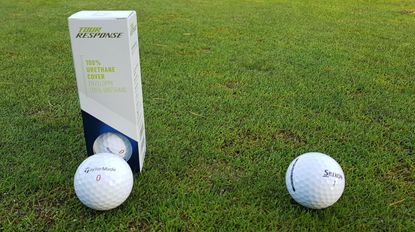
Ball Flight
Which ball should you choose.

The Tour Response offers premium-like performance without the price tag. It is great for those who have a faster-than-average swing speed and want good control around the greens too.
- Great all-round feel
- Distance off the tee
- More affordable price
- Slightly quicker swing speed needed
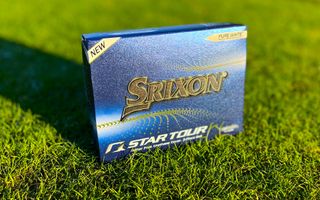
With a short game feel and control to rival many premium models, the Srixon Q-Star Tour is a hugely impressive performer in the increasingly competitive mid-priced golf ball category.
- Impressive short game spin
- Delivers good height and distance
- Soft feel off the putter
- Price is near tour level balls
In this review, we compare the TaylorMade Tour Response golf ball with the Srixon Q-Star Tour, to see which of these mid-range balls delivers the best performance for golfers on a budget.
TaylorMade consumer surveys found that many golfers play expensive premium balls that aren’t suited to their actual playing ability and wanted to tempt golfers to look beyond market leading tour balls.
The result was the TaylorMade Tour Response. Srixon is also targeting the same golf demographic with its Q-Star Tour ball, its softest ball delivering tour level performance.
Both balls are made with urethane covers, the gold standard material used to cover most of the best golf balls and both have an overall compression around the 70-72 mark, significantly lower than market-leading balls like the Titleist Pro V1 and Pro V1x .
We tested both on the golf course and on a launch monitor to see how they compared.
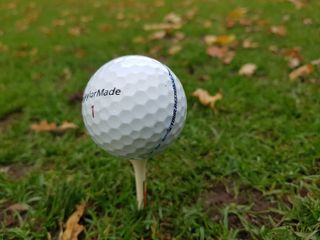
The TaylorMade Tour Response looks like an expensive premium ball. Its 322 dimples form a clean uniform pattern and it has a quality soft and tacky feel in the hand.
The numbers on the Tour Response are deep red and its branded alignment arrow shows the ball name as well as making it easy to line up drives and putts.
Get the Golf Monthly Newsletter
Subscribe to the Golf Monthly newsletter to stay up to date with all the latest tour news, equipment news, reviews, head-to-heads and buyer’s guides from our team of experienced experts.
Srixon’s Q-Star Tour ball looks and feels like its top-end Z-STAR ball but has a black number instead of red. The black alignment arrow on the side is a nice touch combining the ball name and a handy aiming guide off the tee and on the greens. As a urethane covered ball, it also has a nice sticky feel in the hand.

The TaylorMade Tour Response felt firmer than the Srixon Q-Star Tour, especially off the putter face and wedges, and with finesse shots around the green.
Srixon uses SpinSkin with SeRM, a form of flexible coating which it says digs deep into wedge and iron grooves for increased friction and maximum spin. In short game testing, both balls performed well, offer plenty of stop and a predictable reaction on landing. On pure feel and feedback, I enjoyed chipping and pitching the Srixon ball more.
It seemed softer and more responsive, especially when I didn’t quite middle it.
With centre strikes and good shots, the Tour Response reacts well, with plenty of spring and energy, but mishit shots felt dull and a little lifeless. Sometimes, the ball felt heavy and dense off the face.
The Srixon Q-Star Tour felt superior around the greens, generating more spin, especially on short to mid-range low flighted pitches. On higher softer shots, like lobs and greenside pitches, both balls performed about the same.
- Read our full TaylorMade Tour Response Ball review
The flight and spin profiles of the TaylorMade Tour Response and Srixon Q-Star Tour are similar. Both balls are pitched as mid-high launch and low spin and this pattern had merit during on-course and launch monitor testing.
For two balls with high launch low-spin characteristics and a softer compression core, you’d expect similar results. With mid to long irons, I got similar flight profiles but more stability in the flight with the Tour Response.
Both balls stopped quickly on approach shots into greens but the Tour Response flies a lot like the best TaylorMade golf balls with less spin and a straighter flight that doesn’t deviate.
The Q-Star Tour ball flew higher for me and was marginally less accurate in terms of dispersion on the launch monitor.
It was hard to separate the balls in terms of distance control in a round of mid-iron testing. Both were as long as tour balls I’ve played and averaged over 170 yards with 7-iron in testing – further than my stock yardage of 169 – recorded on a gapping test with a Pro V1x using a Foresight GC2 launch monitor.
In driver testing, TaylorMade Tour Response was a clear favourite for me.
It launched high and flew with a stable consistent flight. The spin rate was a touch high at just below 3000rpm, but it didn’t prevent the ball getting out there. On course, in a stiff breeze, it flew with a nice rainbow flight and seemed to cut through wind well.
The Srixon Q-Star Tour launched and flew higher but felt spinny on the course and testing it on the launch monitor, I just couldn’t get the distance I was achieving with the Tour Response.
Both balls performed well around the green, the Srixon Q-Star Tour edging it slightly because of its combination its softer feel and grippier cover on chips and pitches.
Launch monitor testing showed that the Q-Star Tour span more with my wedges than the TaylorMade Tour Response but that the TaylorMade ball held a tighter dispersion and was generally more consistent in peak flight.
The TaylorMade Tour Response ball feels like a softer and cheaper version of the brand’s elite TP5 and TP5 X balls with its only downside being a firm, dull feel on off-centre strikes.
Srixon’s Q-Star Tour excels around the green and held its own in long game testing but didn’t click for me off the tee.
Considering the price point, I would rate both balls comfortably in the best mid-price golf balls category delivering tour-like performance, soft feel and ample distance. It’s likely that moderate to slower swingers will experience better distance gains by switching to a softer lower compression ball with a thinner faster cover.
Choose the TaylorMade Tour Response if... - You want a value-for-money three piece golf ball that performs close to premium equivalents - You want higher launch, consistent distance and stable flight in the long game - You prefer a firmer feel on short shots - Value durability over time
Choose the Srixon Q-Star Tour if… - You like a soft feeling high spinning ball around the greens - Want to flight it higher with your irons and driver - You are already accurate with your iron play but need short game improvements
Matthew Moore fell in love with golf hitting an old 3-iron around his school playing field imagining rugby posts were flags and long jump pits as bunkers.
He earned golf scholarships to the University of St Andrews and Emory University, Atlanta, U.S.A and dreamed of playing professionally before training as a journalist.
He has worked at Golf Monthly and CNN Sports as well as covering golf news, features, products and travel as a freelance writer and TV presenter for newspapers, magazines and corporate clients. Matthew has interviewed Ryder Cup Captains, Major Champions and legends of the game and rates sharing a glass of rioja and a bowl of nuts with Miguel Angel Jimenez as his favourite moment. Matthew plays off 1, has won five club championships and aced the first hole of Augusta National’s Par-3 course in 2002.

TaylorMade’s Tour Response tested against its sister ball – TaylorMade Soft Response
By Matthew Moore Published 25 November 21
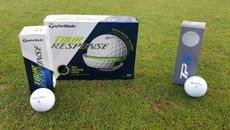
Which ball came out on top in a head-to-head between TaylorMade’s tour performance golf balls?
By Matthew Moore Last updated 8 September 22
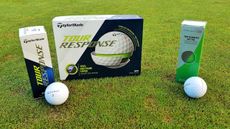
TaylorMade’s Tour Response ball tested against its sibling rival – TaylorMade Project (a)
By Matthew Moore Last updated 21 July 22
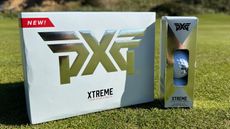
Joe Ferguson takes a look at the newest premium golf ball offering from PXG to see what golfers can expect
By Joe Ferguson Published 26 September 24

It's exactly a year to go before the Ryder Cup gets underway at Bethpage Black and, with 365 days left until the first tee shot, there are still a lot of questions that need answering...
By Matt Cradock Published 25 September 24
- Contact Future's experts
- Terms and conditions
- Privacy policy
- Accessibility statement
- Cookies policy
- Advertise with us
Golf Monthly is part of Future plc, an international media group and leading digital publisher. Visit our corporate site . © Future Publishing Limited Quay House, The Ambury, Bath BA1 1UA. All rights reserved. England and Wales company registration number 2008885.

IMAGES
VIDEO
COMMENTS
TaylorMade Tour Response Golf Balls - Compression. On our gauge, the 2022 TaylorMade Tour Response has an average compression of 73. That's one point firmer than the 2020 model. Suffice it to say that the compression is functionally identical. By way of comparison, that puts it within a couple of points of the prior-gen Bridgestone TOUR B ...
The Tour Response 2022 comes in with a recommended retail price of £39.99 so whilst it may undercut many Tour-played models, it's hardly a budget alternative. At this price, we would still expect a very good all-round performer. We started our testing by hitting some 50-yard pitch shots on a SkyTrak launch monitor.
Tour Response. For as long as there have been urethane golf balls, Tour players have used them. It's the industry standard for premium performance in golf balls, that's truly undeniable. Tour Response brings that same standard to all golfers at an affordable price. It's the same 100% cast urethane cover that's found on TP5/TP5x.
TaylorMade Tour Response is a low compression ball, measured around 70 compression, so you'd expect it to fell softer compared to the TP5 which is an 85 compression ball. It was difficult to tell which had the softer feel in testing. Both are excellent on well struck shots but on off centre contact the Tour Response feels firm, solid, even a ...
Tour Response has a deep red number, Soft Response numbers are black. Both balls have 322 dimples but those on the Tour Response are more uniform and equally proportioned whereas the Soft Response dimples are eye-catchingly different. TaylorMade calls this its extended flight dimple pattern, meant simply to launch the ball higher and fly for ...
On the golf course, the Tour Response spins, and it stops, but it certainly rolls out further than the Pro V1 and the TaylorMade TP5. There is certainly a difference between a 3-piece and a 4 or 5-piece golf ball, and it is seen around the greens. TaylorMade says that the spin on the Tour Response iron approach is lower than the TP5.
PRICE: Tour Response and Tour Response Stripe, which features a wide aiming line along the circumference of the ball, $40 per dozen. Soft Response, $30 per dozen. Soft Response, $30 per dozen.
The variation in core color may be cause for concern over a larger sample. However, the data we have suggests that if you're looking for a soft (sub-75 compression) urethane ball, the Tour Response is likely the one to beat. The "True Price" of the TaylorMade Tour Response is $38.17. That's an increase of nine percent over retail.
Here, we'll compare the TaylorMade Tour Response to some other popular brands in both the premium and mid-priced categories. Premium Brands. The TP5 and TP5x balls from TaylorMade are often compared to the Tour Response, as they are also made with a urethane cover. The TP5x ball is designed for higher swing speeds and offers more distance ...
At A Glance. The biggest difference technical between the TaylorMade Tour Response and the TaylorMade TP5 is the number of layers. Tour Response is a 3-layer ball with a soft tough urethane cover, whereas the TP5 is a 5-piece ball with a cast urethane cover. We'll see how this affects performance when we get into the driving and wedge spin data.
The new TaylorMade Tour Response balls start at $43.99 USD for a case, whereas the Soft Response balls only start at $27.49 for a case. This is quite a big price gap between the two and there are a couple of reasons for this. The Tour Response balls are geared towards high swing speed golfers, which will be the low handicap and tour players.
In our TaylorMade Tour Response review, we explore the design, performance, and durability of this 3-piece golf ball. Discover its tour-level performance, soft feel, distance consistency, and affordable price. Design and Construction 3-piece construction. The design and construction of a golf ball play a crucial role in its performance on the ...
The flight and spin profiles of the TaylorMade Tour Response and the Titleist Pro V1 are quite different and this bore out in testing, especially with the driver and irons. The Tour Response is a high launch low-spin ball with a softer compression core. The Titleist Pro V1 is designed to launch lower and spin less, flying with a penetrating ...
Compression: TaylorMade Tour Response vs Titleist Pro V1. The Titleist Pro V1 has a compression of over 100 (our robot golf ball test measured it at 101.8), while the Titleist Pro V1x has a compression of 108.4, making it the firmest golf ball in our entire test. That's because they're designed for tour players with swing speeds typically in the range of 110-130mph.
The first ball we will compare is the Taylormade Tour Response. Design: The design of the Taylormade tour is a three-layer ball with a softcore. The outer layer is designed to minimize the spin, while the inner core speeds up the ball. Distance: The Taylormade Tour Response offers a low-compression golf ball with a high launch and low drag ...
The TaylorMade Tour Response golf ball is a great mid range golf ball that offers consistent performance at a reasonable price point. Higher ball speeds off the face and control and soft feel around and on the green means this is great for someone with a mid range swing speed. The TaylorMade Tour response comes as a standard ball with an arrow ...
The TaylorMade Tour Response is a solid all-around ball. It balances distance, feel, and spin. It has proven to be durable for me throughout the season. This ball would be ideal for a mid handicapper (scores between 82-94) who is looking for a ball that does everything. ... I was ideally looking to compare the TaylorMade Tour Response to my ...
The wedge spin on the TaylorMade Tour Response is its best asset in my eyes. It's more affordable than a TP5 but returned an outstanding spin rate on full wedge strikes, chips, flops, and bunker shots. I notched up 10540 rpm backspin on my full wedge shots, 400 more than I produced with the Soft Response range.
Overall the 2022 Tour Response ball is a step up in long game performance which combines well with the short game benefits on offer. As such it is a good all-round golf ball which further differentiates itself thanks to the Stripe detailing. As a result if you want a ball that nearly competes with the top models on the market, and has a design ...
Tour Response is engineered to respond to your game with a 100% urethane cover for added greenside spin and better feel compared to ionomer. The soft material helps wedge grooves grip the ball better on shots into the green, while maintaining shear resistance and greater durability. Tour Response is also offered in hi-visibility yellow.
Tour Response Stripe is engineered to respond to your game with a 100% urethane cover for added greenside spin and better feel vs. ionomer. The soft material helps wedge grooves grip the ball better on shots into the green, while maintaining shear resistance and greater durability.
The Taylormade Tour Response is very close in performance to the Taylormade Flagship golf balls the TP5 and TP5x and the Titleist Pro V1. If you are looking for a golf ball that provides good distance while holding its line. Has better control especially around the greens in comparison to the majority of mid-priced golf balls at an affordable ...
Feel. The TaylorMade Tour Response felt firmer than the Srixon Q-Star Tour, especially off the putter face and wedges, and with finesse shots around the green. Srixon uses SpinSkin with SeRM, a form of flexible coating which it says digs deep into wedge and iron grooves for increased friction and maximum spin.
While the TaylorMade Tour Response and the Srixon Q-Star Tour 4 share some similarities, they also have distinct differences that make them suitable for different types of golfers. The TaylorMade Tour Response is a versatile all-rounder, making it ideal for mid-handicappers who want a ball that performs well in all aspects of the game.